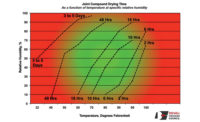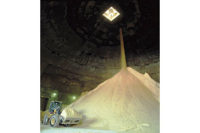GA-216: The Drywall Hanger's Bible
With the new release of GA-216, it’s important to know the significance of the role it serves in the construction industry.




The Gypsum Association recently released the latest edition of Application and Finishing of Gypsum Panel Products, GA-216-2016. Press releases made many salient points about this document, including the fact that it is referenced in the International Building Code as an appropriate standard for the application and installation of gypsum boards and panels. However, there is much more that should be known about this relatively slim but incredibly important GA document.
While the Fire Resistance Design Manual, GA-600 is considered the Association’s flagship publication, GA-216 is colloquially known as the “Drywall Hanger’s Bible”. Just within over twenty pages, Application and Finishing of Gypsum Panel Products provides virtually everything you need to know about hanging interior gypsum panels of every type and under a wide variety of circumstances commonly encountered in the field. Where other GA publications provide greater detail or clarity on the issue, GA-216 directs readers to those publications, many of which are free to the public. When addressing control joints in acoustical and fire rated systems, Application and Finishing of Gypsum Panel Products references both GA-600 and Control Joints for Fire-Resistance Rated Systems, GA-234, which is available for free download in the association’s online bookstore.
Making the Job Easier
GA-216 cannot provide the experience necessary to become skilled in the drywall trade. Nonetheless, if proper procedures are followed, less experienced drywall hangers can avoid learning things the hard way. In fact, many callers to the GA technical hotline are seasoned contractors who know, for example, that control joints are necessary for walls exceeding 30-feet in unbroken length and are seeking support for their position. After many years in the trade, a drywall contractor understands that being called back to a job for a post-crack fix means a loss of time and money.
This leads to another easily overlooked aspect of GA-216, namely alignment of expectations among design and construction professionals as well as the building owner or their agent. While we can all wish that it were different, the fact is that design and construction is a business in which various and competing interests are associated with every project, and minimizing risk often means passing it on to someone else. Given this situation and the fact that GA-216 is a standard, often code referenced document, familiarity with the specification can make everyone’s life a little more predictable while satisfying owner, designer, and contractor.
Both design and construction professionals can and should use GA-216 as a basis for communication. If the architect specified that abuse resistant or impact resistant gypsum panel products should be installed per GA-216, and left it at that, a contractor has every right to confirm that the base metal thickness of the steel studs is at least 0.0312-inches and complies with ASTM C645, Standard Specification for Nonstructural Steel Framing Members. Similarly, an architect should be able to assume that a curved surface will be installed with reference to the bending radii table in GA-216 and that the application methods reflect all relevant sections of 17.2-17.4. Familiarity with GA-216 truly can lead to fewer change orders, and minimize rework, call backs, and the number of punch list items.
So, What’s New in GA-216-2016?
This edition includes specifications for the application of gypsum panels to flat wall insulating concrete forms. This building product is gaining acceptance among residential, multifamily, and commercial builders due to its combination of high thermal mass and insulating attributes, which reduces heating and cooling costs. Gypsum wallboard is the most popular interior finish for these structures. GA-216-2016 provides needed guidance in this growing construction field.
These concrete forming systems for walls, floors, and roofs allow concrete to be poured in place quickly and efficiently. Prior to the pour, the forms are tied together with plastic or metal cross tie flanges, which remain in place after the pour. The flanges on these cross ties create a fastening strip for exterior and interior finishes. Application and Finishing of Gypsum Panel Productsspecifies the orientation and maximum spacing of these plastic or metal strips and notes the proper location of vertical joints and the distance between joints and the strips to which they are attached. Fasteners and fastener spacing is also addressed.
In Florida, ICF building is being explored as a method of resilient construction by the University of Florida’s School of Natural Resources and the Environment. As we know, Florida and California have some of the most stringent building codes and licensure requirements for contractors in the nation. Application and Finishing of Gypsum Panel Productsis required reading for those taking licensure exams in both states so the inclusion of this new building system in GA-216 is not only appropriate but also a necessary addition.
Keeping Up With the Times
When GA-216 was first published in 1974, it bore the title Recommended Specifications for the Application and Finishing of Gypsum Board, a successor document to a 1960s specification developed by the GA in partnership with the National Association of Home Builders. As I sit here at the GA office with a file copy of the original in hand, it is interesting to note that many of the methods of installation and finishing have remained the same.
In addition to an increase in the number of methods of application, the number and variety of board types has expanded over the decades leading to a 2004 change in the title that replaced the term “gypsum board” with “gypsum panel products” defined in ASTM C11 Standard Terminology Relating to Gypsum and Related Building Materials and Systemsas, “a family of sheet products consisting essentially of gypsum.”
Due to constant innovation on the part of GA member companies that family has expanded significantly even in the last ten years. Weight and thickness options are many. Glass mat panels are available for both interior and exterior applications. Specialized performance boards such as abuse-resistant and impact-resistant panels, mold and moisture resistant panels and acoustical panels have been developed to address specific needs. Even in the realm of fire resistance—the most essential feature of gypsum wallboard—member companies make enhanced fire-resistance boards of various kinds.
One Last Word
By the time this magazine hits the streets, the electronic version of GA-216-2016 will be available. Presented in e-book format, Application and Finishing of Gypsum Panel Productswill be fully searchable, making it far easier to read and reference than previous PDF versions. This is just one of many exciting things happening at the Gypsum Association; be sure to visit us online soon to check out ongoing improvements to our website, products, and services.
Looking for a reprint of this article?
From high-res PDFs to custom plaques, order your copy today!







